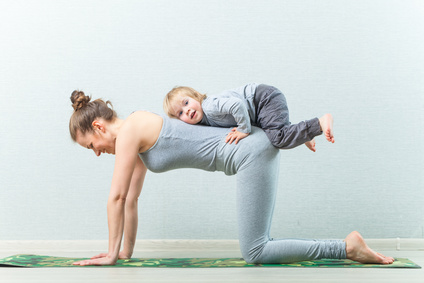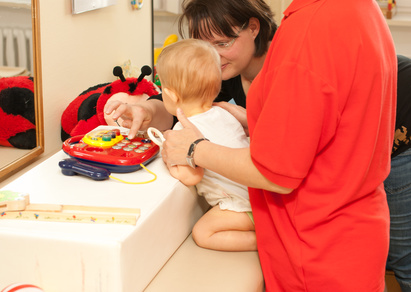“Put your hands on your hips!”
A lot of people’s response is putting the hands on the waist at the top of the pelvic bones. The true hip joint from a Physio’s perspective is basically where the legs attach into the torso. The crease of the groin delineates this. You can also landmark by placing the heels of the hands at the top of the pelvis and the finger tips reach the greater trochanter of the long bone of the femur.
The hip, like the shoulder is a ball in socket joint. The joint is made of the hip socket, or the acetabulum of the pelvis), and the ball-like top of the thigh bone (the femoral head). The shoulder is more mobile and the hip joint is more stable. It is surrounded a cartilaginous labrum, strong ligaments connecting bone to bone, and big strong muscles.
What is developmental dysplasia of the hip (DDH)?
Hip dysplasia in babies occurs when the socket, or acetabulum is too shallow to cover the head of the femur / thighbone. The issue can also be with the femoral head. Dysplasia of the hip can range in severity and can affect one or both hip joints. Babies with dysplasia may have minor looseness of the hip to joints that come easily out of the socket.
It is common during well baby checks for babies to have their hips checked. This means that most babies are diagnosed with hip dysplasia in the first few months. This also means that treatment or monitoring can begin early.
If there are concerns of hip dysplasia in infants it is usually diagnosed with an X-ray or ultrasound imaging.
Common Symptoms of Developmental Hip Dysplasia:
- One leg may appear to be shorter (this is the affected side)
- The folds of the skin at the buttocks or thighs may look uneven from right to left
- With movement of the hip there may be a sensation of popping
- Less mobility or movement on one side
- Limping once a child is walking
- Toe walking
- Waddling or duck-like gait.
As a parent or caregiver if you notice these and the baby has not been identified as having hip dysplasia, bring it to the attention of your paediatrician or family doctor for monitoring. It is important to identify and treat hip dysplasia early for best outcomes.
Causes of Hip Dysplasia?
It is not always know what the case of hip dysplasia is in infants. It is believed that there are many factors that can lead its development.
- The shape of the pelvis may have a genetic component. If there is a family history of hip dysplasia, such as a biological parent or close relative.
- Girls are more likely to have hip dysplasia
- Left hip. The left hip is more commonly affected than the right.
- Birth order – babies who are born first are more likely than later Bronte babies to have hip dysplasia. This is because the uterus is a tighter fit.
- Birth weight over 9lbs
- Decreased amniotic fluid volumes
- Twins. Infant twins are more likely to have hip dysaplsia for the same reasons as above.
- Feet down or breech positioning during pregnancy. The legs may stay extended rather than tucked up in the fetal position. Staying in a straight position may inhibit the hip joints from developing properly.
- Swaddling the infant tightly with the legs extended. This may inhibit the healthy / natural joint development .
Non-Surgical Treatments for Hip Dysplasia:
Observation / Wait and See
If the baby is less than 3 months of age and the hip joint is stable a wait and see approach is often taken. Education regarding swaddling, positioning and gross motor skills are helpful here. This may be done through the paediatrician or specialist as well as a Physiotherapist who works with babies. It is possible for the hip joint to form well on its own as the baby grows and develops.
Harness or Brace:
If the hip joint is unstable or more shallow it may be recommended that they wear a harness or brace. A harness called the Pavlik harness is used for babies under 4 months. It holds the hips in place and allows the legs some movement. It is generally worn 24 hours a day over 8 to 12 weeks. They will be monitored using ultrasound over this time. after the use of the harness they will be monitored over the next few years depending on the severity of the original dysplasia.
What is the Role of a Physiotherapist in Treating Hip Dysplasia in infants?
Physio for hip dysplasia depends on the age of the patient. It also depends on the chosen course of treatment.
Physio can be used to strengthening the muscles around the hips and work on gross motor skills. Gross motor skills include things like rolling, meeting feet to hands, crawling, and sitting. This is important if the baby is also slightly delayed by use of the brace or harness.
If the baby is not braced or harness, the Physio will comment on ideal hip positioning. Avoiding straight legs with knees together and encouraging the hips to fall apart to the sides. This is called a jockey position, or frog position. Using a baby sleep sack is another way to help this natural positioning.
Your Physiotherapist can help identify the positioning that looks best for your little one as well as baby wearing positions or carrying positions. They will also discuss how to optimally swaddle to avoid the tight legs extended position for your baby.
Some of our North Oakville Physiotherapists have a special interest in helping your little ones along. We do see and treat infants and children in our North Oakville Physio and Massage clinic. We are also able to provide follow-up Physio treatments and consultations via video. Private Physiotherapy for infants and children can be covered by your extended health plans. We are able to direct bill to most insurance companies.
Contact us to book in with one of our Halton Physiotherapists who treats infants and children also.



